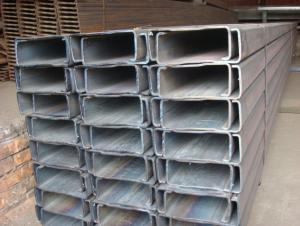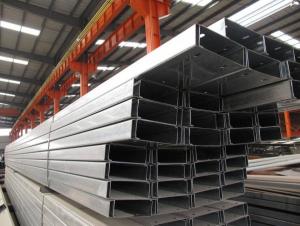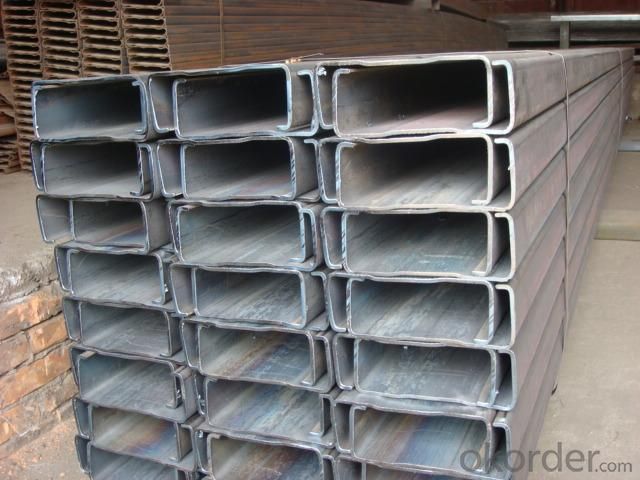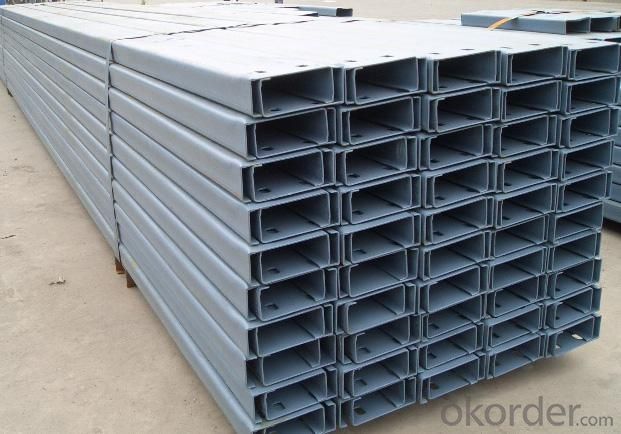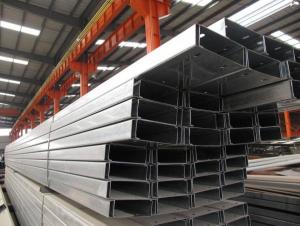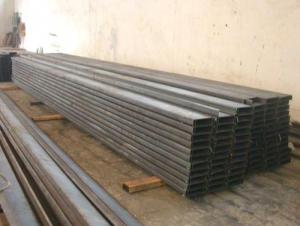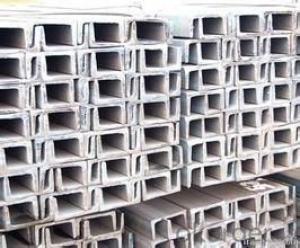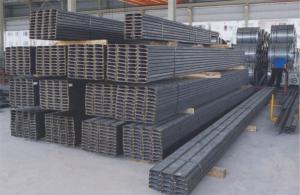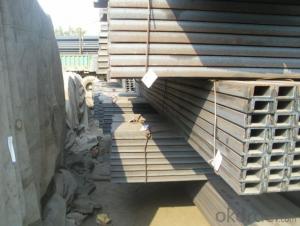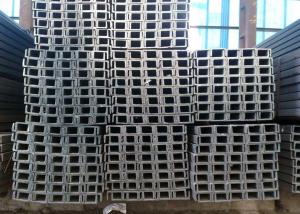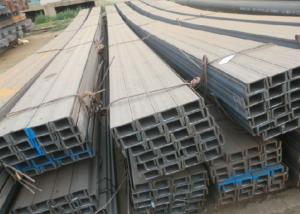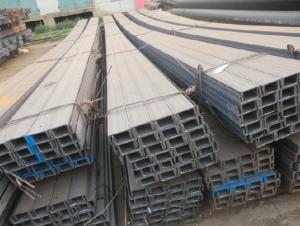Mild Carbon C Channel
- Loading Port:
- Tianjin Port,China
- Payment Terms:
- TT or LC
- Min Order Qty:
- 50MT m.t.
- Supply Capability:
- 1000 Tons Per Month m.t./month
OKorder Service Pledge
OKorder Financial Service
You Might Also Like
Specifications of Mild Carbon C Channel:
1.We supply high quality Mild Carbon C Channel at reasonable price, including Chinese standard, Japanese standard and so on.
Standard | GB/JIS/EN/ASTM/DIN |
Material Grade | Q235B,Q235,Q345,Q345B,SS400,S235JRG1,A36,ST37-2 |
Technique: | Cold Rolled |
Sizes as per chinese standard: |
80×40×20×2.5 - 180×60×20×2.5
|
Sizes as per Japanese standard: |
180×60×20×3 – 300×80×20×3 |
Length: | 6meter, 9meter, 12meter |
Note: we are also competent to provide our customers other Mild Carbon C Channel based on other sizes according to customer’s requirements.
2. The detailed sections of Mild Carbon C Channel as per GB standard.Just as followings in the table-1:
Size | Weight(kg/m) | Size | Weight(kg/m) |
80×40×20×2.5 | 3.925 | 180×60×20×3 | 8.007 |
80×40×20×3 | 4.71 | 180×70×20×2.5 | 7.065 |
100×50×20×2.5 | 4.71 | 180×70×20×3 | 8.478 |
100×50×20×3 | 5.652 | 200×50×20×2.5 | 6.673 |
120×50×20×2.5 | 5.103 | 200×50×20×3 | 8.007 |
120×50×20×3 | 6.123 | 200×60×20×2.5 | 7.065 |
120×60×20×2.5 | 5.495 | 200×60×20×3 | 8.478 |
120×60×20×3 | 6.594 | 200×70×20×2.5 | 7.458 |
120×70×20×2.5 | 5.888 | 200×70×20×3 | 8.949 |
120×70×20×3 | 7.065 | 220×60×20×2.5 | 7.4567 |
140×50×20×2.5 | 5.495 | 220×60×20×3 | 8.949 |
140×50×20×3 | 6.594 | 220×70×20×2.5 | 7.85 |
160×50×20×2.5 | 5.888 | 220×70×20×3 | 9.42 |
160×50×20×3 | 7.065 | 250×75×20×2.5 | 8.634 |
160×60×20×2.5 | 6.28 | 250×75×20×3 | 10.362 |
160×60×20×3 | 7.536 | 280×80×20×2.5 | 9.42 |
160×70×20×2.5 | 6.673 | 280×80×20×3 | 11.304 |
160×70×20×3 | 8.007 | 300×80×20×2.5 | 9.813 |
180×50×20×2.5 | 6.28 | 300×80×20×3 | 11.775 |
180×50×20×3 | 7.536 | ||
180×60×20×2.5 | 6.673 |
Table-1
3. The chemical composition of Mild Carbon C Channel according to Q235B is shown in Table-2.
Alloy No | Grade | Element(%) | ||||
C | Mn | S | P | Si | ||
Q235 | B | 0.12-0.20 | 0.3-0.7 | ≦0.045 | ≦0.045 | ≦0.3 |
Table-2
Note: we are able to present our customers relevant SGS test report for chemical composition of Mild Carbon C Channel.
4. The mechanical property of Mild Carbon C Channel according to Q235B is shown in Table-3-1 and Table-3-2
Alloy No | Grade | Yielding Strength Point(Mpa) | |||
Thickness(mm) | |||||
≦16 | >16-40 | >40-60 | >60-100 | ||
≧ | |||||
Q235 | B | 235 | 225 | 215 | 205 |
Table-3-1
Alloy No | Grade | Tensile Strength(Mpa) | Elongation After Fracture(%) | |||
Thickness(mm) | ||||||
≦16 | >16-40 | >40-60 | >60-100 | |||
≧ | ||||||
G235 | B | 375-500 | 26 | 25 | 24 | 23 |
Table-3-2
Note: we are able to present our customers relevant SGS test report for mechanical property of Mild Carbon C Channel as customer’s request.
Applications of Mild Carbon C Channel:
The Mild Carbon C Channel can be applied to construction of warehouses, workshops, sport stadiums and car parks etc.The hot rolled channel steel belongs to carbon structural steel which is applied to in the field of construction and machinery.In details, the hot rolled channel steel is usually used for arch-itechtural structure, and they could be welded in order to support or hang a vari-ety of facilities. They are also usually used in combination with I beam. Generally,the hot rolled channel steel we supply must possess perfect welding property, riveting property and mechanical property and so on.
Package & Delivery of Mild Carbon C Channel:
1.The hot rolled channel steel will be packed in bundle with steel wire at each end of every bundle and color marking in order to help the customer to recognize his goods more easily at sight.
2. And the hot rolled channel steel could be loaded into 20ft or 40ft container, or by bulk cargo.If the weight of each bundle reaches more than 3.5 mt, the loading by break bulk cargo should be choosed.When the weight of each bundle reaches less than 3mt, the loading by container should be choosed.
3.As for the transportaion from mill to loading port, the truck will be usually used. And the maximum quantity for each truck is 40mt.
4.All in all, we could do in accordance with customer's request.
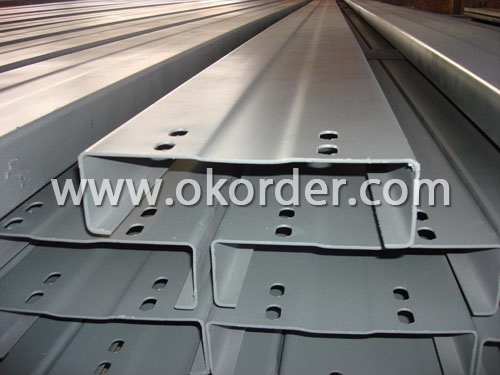
Production Flow of Mild Carbon C Channel:
1.The steel billet shall be heated in the high temperature furnace.
2. The heated steel billet shall be rolled five to nine times with the aim of shaping the general figure of steel u channel.
3. The hot rolled channel steel should be put onto the cooling bed to make the temperature low.
4. The channel steel should be straighted on the straightener.
5. The straighted channel steel will be cut into meters by saw, as per customer's requirements.
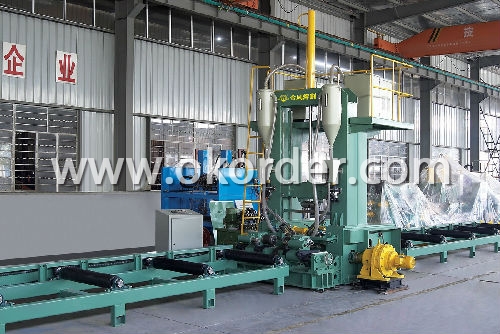
- Q: How do steel channels contribute to the overall energy efficiency of a structure?
- Steel channels can contribute to the overall energy efficiency of a structure in several ways. Firstly, steel channels are commonly used in the construction of walls and roofs. These channels provide structural support and help distribute the weight of the building evenly. By using steel channels, the overall weight of the structure can be reduced, leading to lower energy consumption during construction and throughout the building's lifespan. Additionally, steel channels can be designed to provide insulation properties. Thermal bridging is a common issue in buildings where heat is transferred through materials that have higher thermal conductivity. However, steel channels can be engineered to minimize thermal bridging by incorporating insulation materials or thermal breaks. This reduces the transfer of heat between the interior and exterior of the building, resulting in improved energy efficiency. Furthermore, steel channels are known for their durability and strength. This allows for the construction of larger spans and open spaces, reducing the need for additional support columns or walls. By maximizing the use of open spaces, natural light and ventilation can be optimized, reducing the reliance on artificial lighting and mechanical HVAC systems. This not only decreases energy consumption but also enhances the overall comfort and well-being of the occupants. Lastly, steel channels have the advantage of being recyclable. Steel is one of the most recycled materials in the world, and using recycled steel channels in construction can significantly reduce the environmental impact of building projects. The energy required to produce recycled steel is much lower compared to virgin steel production, further contributing to the overall energy efficiency of the structure. In conclusion, steel channels contribute to the overall energy efficiency of a structure by reducing weight, minimizing thermal bridging, enabling open spaces for natural lighting and ventilation, and being recyclable. By incorporating steel channels in construction, buildings can achieve better energy performance, reducing energy consumption, and promoting sustainability.
- Q: Do steel channels have any specific load distribution characteristics?
- Yes, steel channels do have specific load distribution characteristics. Steel channels are commonly used in structural applications as they provide excellent strength and load-carrying capacity. The load distribution characteristics of steel channels depend on their shape, size, and orientation. Steel channels typically have a C-shaped cross-section, with a flat back and two perpendicular flanges. The load distribution characteristics of steel channels are primarily influenced by the flanges. The flanges act as beams that resist bending and carry the applied load. The load is distributed along the length of the flanges, creating a load path that transfers the load to the supports or other structural elements. The load distribution characteristics of steel channels are also influenced by the size and orientation of the channel. Larger channels with wider flanges can distribute the load over a larger area, reducing the stress concentration. Additionally, the orientation of the channel, whether it is vertical or horizontal, can affect the load distribution characteristics. It is important to consider the load distribution characteristics of steel channels during the design and analysis of structures. Engineers need to ensure that the channels are properly sized and oriented to adequately distribute the applied loads. By considering these characteristics, steel channels can effectively distribute the load and contribute to the overall structural integrity and stability of a construction project.
- Q: Can steel channels be used for balcony supports?
- Yes, steel channels can be used for balcony supports. Steel channels are commonly used in construction and engineering projects for their strength and durability. They provide excellent support for structures, including balconies. When properly designed and installed, steel channels can effectively bear the weight and load of a balcony, ensuring its stability and safety. It is important to consult with a structural engineer or a professional contractor to determine the appropriate size and specification of the steel channels required for the specific balcony design and load requirements.
- Q: Can steel channels be used for signage installations?
- Yes, steel channels can be used for signage installations. They provide strength, durability, and stability, making them suitable for securely mounting and supporting signage.
- Q: How do steel channels perform in extreme temperatures?
- Steel channels generally perform well in extreme temperatures due to their high melting point and excellent thermal conductivity. However, extreme cold temperatures can cause steel to become brittle, potentially leading to reduced structural integrity. Similarly, extremely high temperatures can cause steel to lose its strength and structural stability. Therefore, while steel channels are generally dependable in extreme temperatures, it is essential to consider the specific conditions and potential impact on their performance.
- Q: How do steel channels perform in high-temperature industrial applications?
- Steel channels are widely used in high-temperature industrial applications due to their excellent performance capabilities. One of the key advantages of steel channels in such environments is their high heat resistance. Steel, being a highly durable and heat-resistant material, can withstand extreme temperatures without deformation or degradation. In high-temperature industrial applications, steel channels perform exceptionally well due to their ability to retain their structural integrity, even under constant exposure to elevated temperatures. They can withstand thermal expansion and contraction without warping or bending, ensuring the stability and reliability of the structures they are used in. Moreover, steel channels have excellent corrosion resistance, which is crucial in high-temperature environments where chemicals and gases may be present. The corrosion resistance of steel channels prevents them from deteriorating, even when exposed to aggressive substances, ensuring their longevity and minimizing maintenance requirements. Steel channels also offer high strength and load-bearing capacity, making them suitable for heavy-duty applications in industries such as manufacturing, construction, and oil and gas. Their robustness allows them to support heavy loads and withstand the demands of high-temperature environments without compromising their structural integrity. Furthermore, steel channels are versatile and can be easily customized to meet specific requirements. They come in various sizes, shapes, and thicknesses, allowing for greater flexibility in designing structures for high-temperature industrial applications. This adaptability makes steel channels a preferred choice for engineers and designers working in such industries. In summary, steel channels perform exceptionally well in high-temperature industrial applications. Their heat resistance, corrosion resistance, strength, and versatility make them reliable and durable components for structures exposed to extreme temperatures. Whether it is in furnaces, boilers, or other industrial settings, steel channels provide the necessary stability and functionality required for safe and efficient operations in high-temperature environments.
- Q: What are the different grades of steel used for channels?
- There are several different grades of steel that are commonly used for channels. The specific grade of steel used will depend on the intended application and desired properties. One commonly used grade is A36 steel, which is a low carbon steel known for its excellent weldability and versatility. It is often used for structural applications, including channels, due to its strength and durability. Another frequently used grade is A572 steel, which is a high-strength, low-alloy steel. It offers improved strength and corrosion resistance compared to A36 steel, making it suitable for more demanding applications such as heavy-duty construction projects. Other grades of steel that may be used for channels include A588 steel, which is a weathering steel known for its corrosion resistance, and A500 steel, which is a structural steel commonly used in construction and infrastructure projects. It is important to consult with a structural engineer or steel supplier to determine the most appropriate grade of steel for a specific channel application, taking into consideration factors such as load-bearing capacity, corrosion resistance, and environmental conditions.
- Q: How do steel channels contribute to daylighting in buildings?
- Steel channels can contribute to daylighting in buildings by being used as structural components for large windows or skylights. These channels provide the necessary support and framing for these daylighting features, allowing more natural light to enter the building and reducing the need for artificial lighting.
- Q: Could you tell me the theoretical weight and size of 16 and 18 channel steel?
- Channel steel 16#a specifications 160x, 63x, 6.5mm, theoretical weight of 17.24 kg per meterChannel steel 16#b specifications 160x 65 8.5mm, theoretical weight of 19.752 kg per meterChannel steel 18#a specifications 180X, 68x 7 mm, theoretical weight of 20.174 kg per meterChannel steel 18#b specifications 180 X70 x9mm, theoretical weight of 23 kg per meter
- Q: Can steel channels be used for building facades?
- Indeed, building facades can utilize steel channels effectively. In construction, steel channels are frequently employed due to their exceptional strength and durability. These channels serve to frame and bolster building facades, ensuring structural integrity and stability. By virtue of their adaptability, steel channels can be effortlessly customized and fabricated into diverse forms and dimensions to meet the facade's design specifications. Moreover, steel channels can undergo coating or finishing processes to augment their visual appeal and safeguard against corrosion, rendering them appropriate for both functional and aesthetic purposes in building facades.
1. Manufacturer Overview
| Location | Tianjin,China |
| Year Established | 2006 |
| Annual Output Value | Above US$ 500 Million |
| Main Markets | China; Middle East; Southeast Asia; South America |
| Company Certifications |
2. Manufacturer Certificates
| a) Certification Name | |
| Range | |
| Reference | |
| Validity Period |
3. Manufacturer Capability
| a) Trade Capacity | |
| Nearest Port | Tianjin |
| Export Percentage | 40%-60% |
| No.of Employees in Trade Department | 11-20 People |
| Language Spoken: | English; Chinese |
| b) Factory Information | |
| Factory Size: | Above 50,000 square meters |
| No. of Production Lines | Above 3 |
| Contract Manufacturing | materials for processing; OEM Service Offered |
| Product Price Range | Average |
Send your message to us
Mild Carbon C Channel
- Loading Port:
- Tianjin Port,China
- Payment Terms:
- TT or LC
- Min Order Qty:
- 50MT m.t.
- Supply Capability:
- 1000 Tons Per Month m.t./month
OKorder Service Pledge
OKorder Financial Service
Similar products
Hot products
Hot Searches
Related keywords
